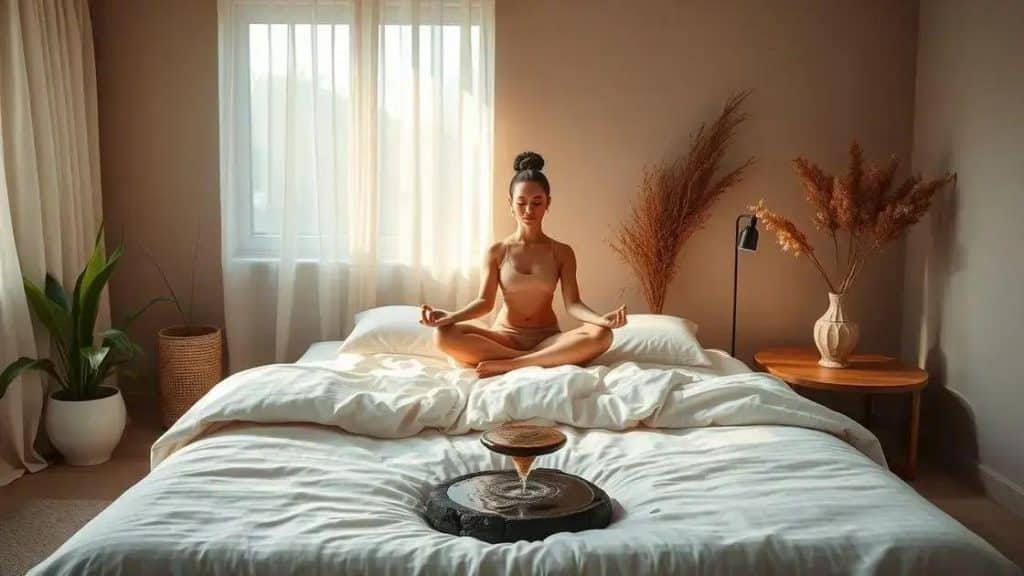Yogic sleep for lucid dreams: unlock your potential

Yogic sleep enhances lucid dreaming by promoting deep relaxation and awareness, allowing individuals to recognize dream states and explore their subconscious more effectively.
Yogic sleep for lucid dreams is a fascinating practice that might just transform your nighttime experience. Have you ever wondered how mastering sleep could unlock your creativity and awareness in dreams? Let’s dive in and explore how you can harness this powerful technique.
What is yogic sleep?
Yogic sleep, also known as Yoga Nidra, is a profound practice that helps individuals relax deeply while still remaining aware. It allows the mind to rest while the body rejuvenates. This practice has roots in ancient Indian traditions and is a popular method for achieving deep relaxation.
Yoga Nidra reaches beyond just physical sleep. During this state, practitioners enter a dream-like state of consciousness where they can explore their inner self. By practicing yogic sleep, you can tap into your subconscious, improving creativity and self-awareness.
How does yogic sleep work?
The process of entering a state of yogic sleep involves guided meditation techniques that focus on different body parts. The goal is to systematically relax and release tension. You may find yourself guided through various breathing exercises, affirmations, and visualizations.
These methods help calm the mind and create a sense of peace. Practitioners often report heightened senses and a feeling of connection with their inner world. In addition, yogic sleep can help to:
- Improve overall sleep quality
- Reduce stress and anxiety levels
- Enhance emotional well-being
- Boost mental clarity and focus
By following a consistent practice, many people discover significant benefits for their mental and emotional health. This ancient technique bridges the gap between awake and asleep, allowing for unique experiences and insights.
While the concept may seem simple, the benefits are profound. With regular practice, yogic sleep can become a powerful tool for personal growth. As you explore this practice, you may find new ways to express your emotions, understand your dreams, and even improve daily life experiences.
Benefits of yogic sleep for lucid dreaming

Yogic sleep offers numerous benefits for those seeking to enhance their lucid dreaming experiences. Practicing this ancient technique not only fosters deep relaxation but also opens the door to greater awareness in the dream state. Many people are curious about how yogic sleep can transform their nighttime rituals and empower their dreams.
One major benefit of yogic sleep is its ability to improve dream recall. By achieving a state of deep relaxation, your mind becomes more attuned to subtleties in your dreams. This practice can help you to remember details that might otherwise fade upon waking.
Enhancing Dream Clarity
Another advantage is that it enhances dream clarity. When you engage in yogic sleep, you train your mind to remain aware even while dreaming. This state can help you recognize when you are in a dream, leading to more frequent lucid dreams.
Furthermore, yogic sleep aids in the exploration of the subconscious. As you relax deeply, you may uncover hidden emotions or insights that can inform your waking life. This journey into the subconscious can enrich your understanding of yourself.
Reducing Nightmares and Anxiety
For those prone to nightmares, practicing yogic sleep can be particularly beneficial. The relaxation techniques foster a sense of calm, reducing anxiety both during sleep and in waking life. With less stress, individuals are less likely to experience disturbing dreams.
- Improved dream recall and clarity
- Increased awareness of dreams
- Better emotional understanding
- Reduction of nightmares and anxiety
Lastly, yogic sleep promotes a more restful night. This practice can lead to overall improved sleep quality, making it easier to transition into a state where lucid dreaming can occur. As you embrace this technique, you may find your dreams becoming more vivid and immersive, opening up new avenues of creativity and exploration.
Techniques to practice yogic sleep
Practicing yogic sleep involves several techniques that can help you access deep relaxation and enhance your awareness during dreams. These methods can make your practice effective and enjoyable, promoting both restful sleep and creative dreaming.
One popular technique is guided visualization. This involves a facilitator or audio recording that leads you through imagery and environments designed to calm your mind. By focusing on peaceful scenes, you will allow your body to relax more deeply, promoting a state conducive to yogic sleep.
Breathing Techniques
Breathing deeply is essential in this practice. Techniques like pranayama help to center your mind and body. Focusing on your breath allows you to release tension, making it easier to enter yogic sleep.
Another effective technique is body scanning. By systematically bringing your awareness to each part of your body, you can identify and release tension. As you gently focus on areas of discomfort, you’ll encourage relaxation. Here are a few tips for body scanning:
- Start from your toes and move to your head.
- Hold your focus on each body part for a few breaths.
- Let go of any tension you feel as you breathe out.
Setting an Intention
Setting a clear intention before you practice can significantly enhance your experience. This intention acts as a guide for your subconscious, helping you focus on specific outcomes in your dreams. It can be as simple as wanting to explore a particular emotion or seeking clarity on a situation.
Finally, maintaining a consistent practice schedule can lead to the best results. Try to practice yogic sleep at the same time each day. This routine trains your mind and body, helping you to quickly access a state of relaxation. The more you practice, the easier it will be to enter this dreamlike state.
Tips for enhancing your lucid dreams with yogic sleep

Enhancing your lucid dreams with yogic sleep can lead you to a more fulfilling dream experience. There are several tips and techniques that can help you maximize the benefits of this practice, allowing you to explore your dreams with greater awareness.
One effective tip is to keep a dream journal. Writing down your dreams as soon as you wake up helps reinforce memories and recognition. This practice strengthens your dream recall and allows you to notice patterns that can signal when you are dreaming.
Set Clear Intentions
Setting clear intentions is another valuable method. Before you practice yogic sleep, think about what you would like to achieve in your dreams. Having a goal can guide your subconscious during sleep and make lucidity more accessible.
Additionally, consider using lucid dreaming triggers. These are techniques or cues that remind you to check if you are dreaming. Common triggers include looking at your hands or a specific object. When you practice these during the day, they will become habits that carry into your dreams.
Incorporate Meditation
Incorporating meditation into your yogic sleep practice can deepen your experience. Regular meditation helps quiet the mind and enhances self-awareness. This heightened awareness translates into your dreams, making it easier to recognize when you are in a dream state.
Consistency is crucial for all of these techniques. Try to establish a regular practice schedule for both yogic sleep and lucid dreaming techniques. The more regularly you engage with these methods, the more you will notice improvements in your ability to achieve lucidity during your dreams.
FAQ – Frequently Asked Questions about Yogic Sleep and Lucid Dreaming
What is yogic sleep?
Yogic sleep, or Yoga Nidra, is a state of conscious awareness during deep relaxation, helping to rejuvenate the mind and body.
How can yogic sleep enhance lucid dreaming?
Yogic sleep promotes relaxation and awareness, making it easier to recognize when you’re dreaming, which increases the chances of lucidity.
What techniques can I use to practice yogic sleep?
Techniques include guided visualization, breath control, body scanning, and setting clear intentions before sleeping.
How often should I practice yogic sleep to see results?
For the best results, practice yogic sleep regularly, ideally at the same time each day, to help train your mind and body.





